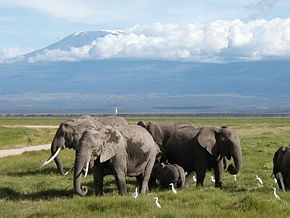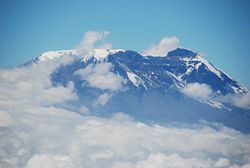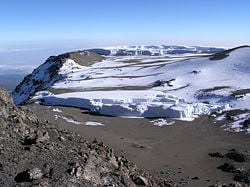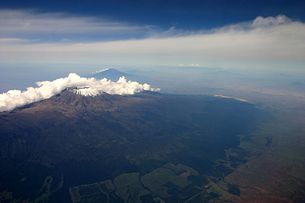Mount Kilimanjaro
| Mount Kilimanjaro | |
|---|---|
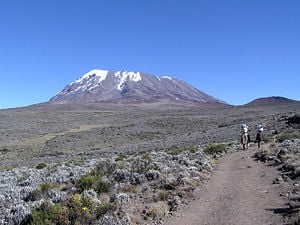 Kibo Summit of Kilimanjaro | |
| Elevation | 5,895 meters (19,341 ft) |
| Location | Tanzania |
| Prominence | 5,885 m (19,303 feet) Ranked 4th |
| Geographic coordinates | Coordinates: |
| Type | Stratovolcano |
| Last eruption | None in recorded history |
| First ascent | 1889 by Hans Meyer, Ludwig Purtscheller, Yohanas Kinyala Lauwo |
| Easiest Climbing route | hike |
Kilimanjaro with its three volcanic cones, Kibo, Mawensi, and Shira, is an inactive stratovolcano in north-eastern Tanzania. Although it does not have the highest elevation, Kilimanjaro is the tallest free-standing mountain rise in the world, rising 4,600 m (15,100 ft) from its base, and includes the highest peak in Africa at 19,340 feet (5,895 meters), providing a dramatic view from the surrounding plains.
Name
It is unknown where the name Kilimanjaro comes from, but a number of theories exist. European explorers had adopted the name by 1860 and reported it as its Swahili name, assuming that Kilimanjaro breaks up into Kilima, Swahili for "hill" or "little mountain", and Njaro, understood to be Swahili for "white"' or for "shining". The The Nuttall Encyclopædia of 1907 contains the following definition "Kilima-Njaro, a volcanic mountain group, 19,000 ft. high, on the northern border of German East Africa, 170 m. from the coast, with two peaks, Kibo and Kimawenzi; in 1894 an Austrian communistic settlement was established on the slopes."
Others believe its origin to be from the Kichagga language word jaro meaning caravan. It is unknown, however, why the diminutive kilima is used instead of the proper word for mountain, mlima. It is conceived that an early European visitor, whose knowledge of the Swahili language was limited, changed mlima to kilima by analogy with the two Chagga names; Kibo and Kimawenzi.
Another theory is that Kilimanjaro comes from the Kichagga word kilemanjaare or kilemajyaro meaning "that which defeats the bird/leopard/caravan". However this theory can't explain the fact that the name Kilimanjaro was not used in Kichagga before European exploration in the mid-1800s. [1]
In the 1880s the mountain, called Kilimandscharo in German, became a part of German East Africa after Karl Peters had persuaded local chiefs to sign treaties. In 1889 Uhuru Peak on Kibo was named Kaiser-Wilhelm-Spitze, which was used in the German Empire until its defeat in 1918, when the territory became British-administered Tanganyika and the name was dropped.
Geography
Kilimanjaro is 340 km south of the Equator, 280 km from the Indian Ocean and just over 400 km from Lake Victoria. It lies on the eastern side of the eastern branch of the Great Rift Valley, and north-north east of the Maasai steppe, the great plain of north-eastern Tanzania renowned as the homeland of the nomadic Maasai cattle-herders.
Principal human habitation lies on the southern and eastern slopes of Kilimanjaro, where the fertile and well-watered soil supports farming, especially of horticultural crops by the Chaga people. The city of Moshi, just over 30 km from the summit, is the main urban centre and has paved highway and rail connections to the Tanzanian coast at Tanga and Dar es Salaam. The area's tourist industry is served by Kilimanjaro International Airport.
The grasslands exploited by the Maasai extend west and north of Kilimanjaro into Kenya as far as Nairobi, 200 km north-north-west. The Kenyan border runs along the lower slopes of the mountain on the north-eastern and eastern sides, only 20 km from the summit. Amboseli National Park in Kenya reaches to the lower slopes on the northern side, while the hot dry savanna plains of Tsavo National Park, also in Kenya, are farther east.
These extensive plains surrounding the mountain have an elevation of 1100–1400 m except in Tsavo, which is lower at 800 m. The only other nearby highlands are a chain of hills running south-east to the coast where they are called the Usambara Mountains, and 50 km to the west-south-west is another isolated volcanic mountain, Mt Meru, above the city of Arusha.
Kilimanjaro's middle and lower slopes catch more rain than the surrounding plains. The southern slopes are the wettest, feeding the Pangani River which has formed a valley flowing south-south-west, parallel to the Usambara Mountains. To the east streams feed the Galana River. The northern slopes drain into the seasonal Lake Amboseli and Kiboko River. Streams on the south-western side join the Pangani.
Kilimanjaro's prominence above the surrounding plains and frequent clear skies enable Kilimanjaro to be seen from the south, west and north from as much as 200 km away – it can often be seen from Nairobi. Although no hills block the view of the mountain from the east, the humid Indian Ocean coast is usually cloudy and hazy. Coastal towns such as Mombasa and Malindi, 280 and 300 km away, are too far and too cloudy for Kilimanjaro to be seen from there, and although Arabs and Europeans have visited these towns for centuries, the mountain was not known to them until the 19th century.
Description
The highest point is Uhuru Peak on the volcano Kibo, 5,895 meters (19,340 ft). Kibo has a 1.5 mile wide crater on the top of it. As the highest point in Africa, Uhuru Peak is one of the Seven Summits. The summit was first reached by the Marangu army scout, Yohanas Kinyala Lauwo, German Hans Meyer and Austrian Ludwig Purtscheller, on October 6 1889. Two other peaks are also extinct volcanoes: Mawenzi (5,149 metres, 16,890 ft), the third highest peak in Africa (after Mount Kenya) and Shira (3,962 m, 13,000 ft). Yohanas' Notch is named after Lauwo.
An ascent of Mawenzi requires rock climbing and/or snow/ice climbing skills. The climb to Uhuru Peak is considered to be a relatively straightforward endeavour; however, ample time must still be provided for proper acclimatization to prevent altitude sickness. The three easiest routes, Marangu, Rongai and Machame can be climbed by a person of good health, and require no mountaineering experience. Many who climb employ altitude-sickness medication and find this to be helpful in preventing the pounding headaches that plague many travellers. Those who travel on the Marangu route usually take 4-5 days to complete their climb. Huts with cooking facilities, bathrooms, and (sometimes) electricity are available at the end of each day's journey, as of October 2007 these are generally disused apart from on the lower parts of the Marangu route and climbers will need to camp. The final part of the climb, from Kibo hut at 15,500 ft (4,720 m) to the summit, is generally undertaken at night, because the scree is frozen together, making the climb significantly easier. Gilman's Point, on the rim of the crater, but about 1½ hours hike from Uhuru, is attained at 5:00 - 6:00 am; those who have the strength to continue may then hike on to Uhuru in the growing sunlight and rising temperatures. Another route is the Western Breach, which is much more technical in nature. Annually, approximately 15,000 people attempt to climb the mountain, of whom 40% reach the summit.
At the summit, there is a sign posted by the Tanzanian government. The sign (printed in English only) reads "Congratulations! You are now at Uhuru Peak, Tanzania, 5,895 m. AMSL. Africa's Highest Point. World's Highest Free-Standing Mountain. One of World's Largest Volcanos. Welcome." The sign is covered in travel stickers from past trekkers who have left their mark on the top of the peak. Near this famous sign is a box containing a log that many climbers have signed. As of January, 2007 this box has either been removed or buried.
Due to the mountain's equatorial location as well as its high elevation, climbers can experience almost every climate type on earth during the journey to the top. It is also known to many for its year round snow-topped summit.
The summit of Kilimanjaro is covered by a GSM mobile phone network, provided by Vodacom. It lost its claim as the highest point in the world with mobile phone service, as China Mobile now provides coverage at the top of Mt. Everest, the highest point in the world.
While it is inactive, Kilimanjaro has fumaroles that emit gas in the crater on the main summit of Kibo. Scientists concluded in 2003 that molten magma is just 400 metres (1,300 ft) below the summit crater. Although new activity is not expected, there are fears the volcano may collapse[citation needed], causing a major eruption similar to the 1980 eruption of Mount St. Helens. Several collapses and landslides have occurred on Kibo in the past, one creating the area known as the western breach. Although there is no recorded history of eruptions, local legend speaks of activity around 170 years ago.
Current conditions
While the volcano appears to be dormant on the inside, events on top of the mountain draw global attention. The top of the mountain has seen a retreat of the most recent covering of glaciers, with the most recent ice cap volume dropping by more than 80%[1]. In 2002, a study led by Ohio State University ice core paleoclimatologist Lonnie Thompson [2] predicted that ice on top of Africa's tallest peak would be gone between 2015 and 2020 [3] [4]. In 2007, a team of Austrian scientists from University of Innsbruck predicted that the plateau ice cap will be gone by 2040, but some ice on the slope will remain longer due to local weather conditions [5]. A comparison of ice core records suggests conditions today are returning to those of 11,000 years ago. A recent study by Philip Mote of the University of Washington in the United States and Georg Kaser of the University of Innsbruck in Austria indicates that the shrinking of Kilimanjaro's ice cap is not due to global warming but instead driven by solar radiation. [6] As of January 2006, the Western Breach route has been closed by the Tanzanian government following a rockslide which killed four people at Arrow Glacier Camp. The rockslide is believed to have been caused by frost action in an area which is no longer permanently frozen.
After the Western Breach route was closed in January 2006, many expeditions that had intended to use this route have instead used the Lemosho/Barafu route. As the Western Breach route, this route starts to the west and goes up the Shira Ridge towards Lava Tower. Instead of going up to Arrow Glacier camp and the breach, however, this route goes around the southern edge of Kili towards Barafu Camp. From Barafu Camp, around 15,200 ft (4,630 m) altitude, a nighttime summit is usually attempted.
Climbing routes
There are several routes officially sanctioned for climbing Kilimanjaro. These are:
- Machame
- Marangu
- Rongai
- Londorossi Lemosho
- Umbwe
- Shira
- Mweka (descent only)
Machame route
The Machame route as of 2006 is described here. The route is typically done on a 6 or 7 day hike.
The campsites and gates (with corresponding elevations) are as follows: [7]
- Machame Gate (start of trek) (5718 ft/1738 m)
- Machame (9927 ft/3018 m)
- Shira (12355 ft/3756 m)
- Barranco (13066 ft/3972 m)
- Karanga (optional camp, used by 6-day climbers)
- Barafu (high camp before summit) (15239 ft/4633 m)
- Mweka (descent) (10204 ft/3102 m)
- Mweka Gate (end of trek) (5423 ft/1649 m)
(The given altitudes are sourced from a GPS device and are accurate to a few hundred feet)
One benefit of the Machame route is its quick rise to relatively high elevations (~10,000 ft/~3,040 metres), and a short ascent to the Lava Tower site (~15,000 ft/~4,560 m) before descending back to Barranco Camp (12,700 ft/3,870 m) on the same day. This follows the climber's adage 'climb high, sleep low', and helps altitude acclimatization. The initial steep ascent also helps climbers acclimatise better.
The Machame route starts from Machame Gate and travels upwards through the montane rainforest, characterized by dense vegetation, a muddy trail and short sections of steep climbs. The first campsite, Machame Camp, is right after the dense tree cover in an area with lower but still thick bushlands.
The second day continues through increasingly sparse trees and bushes into moorlands. Picturesque hanging mosses often cover trees and offer an ethereal quality to the landscape. The day finishes with Shira Camp, which is on a small plateau in the high moorlands, and features views of Kibo in the northwest and Mount Meru towards the east. White necked ravens can be seen throughout the day. There is also a set of small caves a short walk from the campsite known as the Shira Caves.
The third day starts in the moorlands and moves into alpine desert, with less trees and more rocks. The highest point is the base of the Lava Tower, after which the trail descends into the Barranco Valley. More vegetation is present in this zone, especially the area just before the campsite. This area is called the 'Garden of the Senecias' which features many of the huge senecio plants. Shorter lobelia plants are also present.
The fourth day starts with the ascent of the Barranco Wall, which is considered a scramble in climbing terms. The top of the Wall has attractive vistas of Kibo and the surrounding landscape. The trail continues with many up and down sections across small streams and rivulets, and finally crosses the Karanga River to the Karanga campsite.
The fifth day follows the path up and across a rocky zone, finishing at the high camp Barafu. Very little vegetation can be found on the inhospitable terrain. A field of sedimentary rocks litters the ground like many broken mirrors. (Note - the 6 day trek omits the Karanga campsite, and climbers continue directly to Barafu on the same day.)
The summit is usually attempted on the very early morning of the 6th day (around midnight). Barafu is also used as a summit campsite for the Umbwe route. Climbers typically take somewhere between 5-7 hours to ascend, using headlamps and cold weather gear. The first milestone is Stella Point (18,652 ft/5,685 m), which is on the crater rim. Following Stella Point, the trail continues for another 30 mins to the summit - Uhuru Peak.
The descent back to Barafu takes roughly 4 hours. Some climbers 'scree slide' down the slope, which entails skidding/running down the loose gravel at medium speed. From Barafu, climbers typically take a short break, and continue downwards through the alpine desert and ensuing moorlands to Mweka Camp.
The 7th and final day has trekkers continue through the montane forest to Mweka Gate. Troops of black-and-white colobus monkeys can often be seen in the dense growth.
A travelogue of the Machame route can be viewed here.[8] A trip report of the Machame route can be viewed here.[9]
A travelogue of the Londorossi Lemosho route can be viewed here.[10]
National Parks in the Kilimanjaro area
- Kilimanjaro National Park covers 753 km² of the mountain, and is a UNESCO World Heritage Site.
- Amboseli National Park, Kenya is on the northern side.
- Tsavo National Park, Kenya lies to the east.
- Arusha National Park covers neighboring Mt Meru.
Notes
- ↑ Hutchinson, J. A. 1965. The Meaning of Kilimanjaro Tanganyika Notes and Records. Retrieved December 12, 2007.
ReferencesISBN links support NWE through referral fees
- Mitchell, John. 1971. Guide book to Mount Kenya and Kilimanjaro. Nairobi: Mountain Club of Kenya. ISBN 0901516554
- Edward Stanford Ltd. 1905. Equatorial East Africa. London: Edward Stanford.
External links
All Links Retrieved December 12, 2007.
- Volcano World
- Ohio State University study expedition to Kilimanjaro's glaciers
- NASA Earth Explorer page
| |||||
| |||||
Credits
New World Encyclopedia writers and editors rewrote and completed the Wikipedia article in accordance with New World Encyclopedia standards. This article abides by terms of the Creative Commons CC-by-sa 3.0 License (CC-by-sa), which may be used and disseminated with proper attribution. Credit is due under the terms of this license that can reference both the New World Encyclopedia contributors and the selfless volunteer contributors of the Wikimedia Foundation. To cite this article click here for a list of acceptable citing formats.The history of earlier contributions by wikipedians is accessible to researchers here:
The history of this article since it was imported to New World Encyclopedia:
Note: Some restrictions may apply to use of individual images which are separately licensed.
